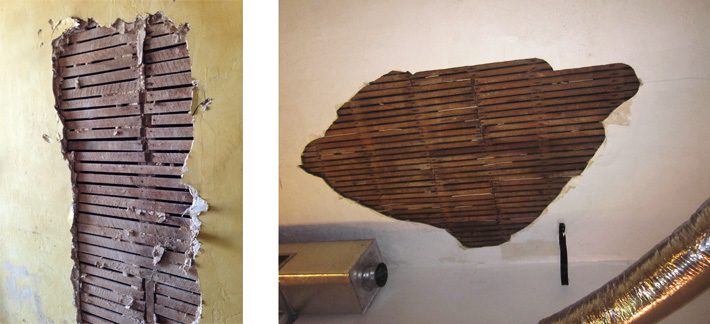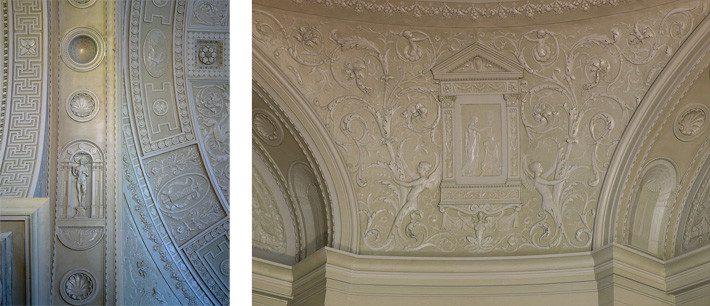Plaster has been a cornerstone of New Orleans architecture for centuries, contributing both beauty and functionality to historic homes. This material, so integral to the city’s architectural legacy, tells a story of tradition, artistry, and resilience. Whether used as an interior finish or on the exterior of buildings, plaster was traditionally made from either lime or gypsum, two materials with distinct characteristics and installation methods. Understanding these differences is crucial for plaster restoration and maintenance in your historic New Orleans home.

Types of Historic Plaster: Lime vs. Gypsum
What Makes Lime Plaster Unique?
Lime plaster has been a staple in historic New Orleans homes, often applied directly to solid surfaces such as brick walls. The plaster adheres to the wall through suction adhesion, a natural bond created by the material’s properties, offering a smooth, durable surface. Not only does lime plaster create an attractive finish, but it also serves an important functional role: it protects the soft locally made bricks from weathering and deterioration, especially given the city’s wet and humid climate.
In the French Quarter and beyond, many buildings feature brightly painted lime plaster, showcasing its timeless appeal. Often coated with pigmented lime wash or paint, the plaster not only enhances the building’s visual charm but also protects the structure beneath.
How Gypsum Plaster Changed the Game
In the early 20th century, gypsum plaster began to replace lime plaster due to its faster setting times. While lime plaster takes several days to set and can take months to dry fully, gypsum plaster sets in minutes and dries in a matter of days, which significantly sped up the construction process.
However, gypsum plaster has certain limitations compared to lime plaster. It is more brittle and susceptible to moisture damage. Unlike lime plaster, which can be applied directly to masonry walls, gypsum plaster requires an air gap as a moisture barrier and cannot be used in the same way in New Orleans’ humid climate.
The Application Process
Traditional Plaster Application
Plaster in historic homes was typically applied in three layers to create a smooth, stable surface. This process included:
- Scratch Coat: A rough base layer containing lime putty, sand, fiber, and water, applied for adhesion.
- Brown Coat: A secondary layer to build up the surface and provide strength.
- Setting Coat: A final layer with a higher concentration of lime putty and no fiber, trowel polished to produce a smooth, white finish. Pigments or quick-setting agents like plaster of Paris were sometimes added to the final coat.

Lath: The Backbone of Plasterwork
Plaster was traditionally applied over lath, a support structure that holds the plaster in place. Types of lath include:
- Wood Lath: Thin wooden strips with gaps, allowing plaster to form “keys”—protrusions of plaster that grip the lath securely. Most commonly used in the 19th century.
- Metal Lath: Mesh that provides a similar bonding surface, often used in later periods.
- Rock Lath: A flat surface embedded with gypsum crystals, designed specifically for use with gypsum plaster.

The Elegance of Ornamental Plaster
Ornamental plaster is one of the most striking features of historic New Orleans homes. From intricate ceiling medallions and crown moldings to decorative cornices and archway details, these elements add elegance and craftsmanship to interiors. Historically, these embellishments were crafted using hand-applied techniques or molds to create designs ranging from simple motifs to elaborate patterns.
Not only were these details decorative, but they also served as indicators of a home’s status and style. Today, these elements remain a defining characteristic of New Orleans’ historic homes, demonstrating exceptional skill and artistry.
There are still master plaster workers in New Orleans that can repair old plaster and manufacture new decorative plaster.

Preserving and Restoring Plaster: Common Challenges & Solutions
Restoring historic plaster comes with unique challenges, from moisture damage to structural settling. Here are some common issues and tips for addressing them:
- Cracks: Often caused by settling and foundation shifts. These should be repaired with compatible materials to ensure proper bonding.
- Moisture Damage: Leaks and humidity can cause plaster to soften and eventually crack. Stabilize humidity levels and address any leaks before attempting repairs.
- Biological Growth: Moisture and poor ventilation can also contribute to mold and mildew. Remove any signs of mold or rot before restoration.
Tips for Homeowners
- Inspect Regularly: Look for signs of cracks, crumbling, or wet spots.
- Use Appropriate Materials: Lime plaster should be repaired with lime-based materials, while a mix of lime and gypsum may be used for ceilings or areas that originally combined both.
- Consult Professionals: Improper repairs can lead to poor adhesion, further damage, or a mismatch in texture.

Restoration in Practice: A Case Study
The Antebellum Guesthouse on Esplanade Avenue offers a compelling example of plaster restoration in a 19th-century New Orleans home. Keith Teachout and his partner rehabilitated their Italianate house, built by Anatole J. Forstall in the late 1830s, into a bed and breakfast, focusing on preserving its double parlor’s intricate plasterwork.
They repaired the flat plaster walls with lime plaster applied to wood lath and meticulously reconstructed the historic plaster cornices that were missing or damaged. This labor-intensive process involved layering lime plaster and running a shaping tool to match the original cornice profile.
The double parlor’s archway, adorned with ornamental plaster brackets, egg-and-dart details, and Bacchus masks, required painstaking restoration. Missing elements were recreated using gypsum plaster (plaster of Paris) cast from molds made from surviving details.
A missing ceiling medallion in the parlor was reproduced with the help of 5th-generation plasterer Jeff Poree, whose family, remarkably, still possessed the original molds. This attention to detail ensured a historically accurate restoration, preserving the home’s legacy for generations to come.

Consult a Professional for Your Plaster Restoration Needs
Restoring or maintaining historic plaster is a specialized skill. Whether you’re restoring a single medallion or an entire wall, there are craftsmen who have been perfecting their trade for over two hundred years.
Jeff Poree, a master plasterer whose family has been preserving historic plaster in New Orleans for generations. His expertise has been instrumental in restoring some of the city’s most significant historic homes and buildings, including the famous Gallier Hall, the Saenger Theatre, New Orleans Museum of Art, and more.
From reconstructing elaborate ceiling medallions to repairing intricate cornices, Poree’s craftsmanship ensures that historic plaster details are not just preserved but authentically replicated. His work is a testament to the enduring skill of traditional plaster artisans. You can learn more about his contributions to plaster restoration in this video.
Additional Resources:
- Preservation Brief No. 21: Repairing Historic Flat Plaster Walls and Ceilings (National Park Service)
- Preservation Brief No. 23: Preserving Historic Ornamental Plaster (National Park Service)
- Vieux Carré Commission Guidelines for Exterior Painting (City of New Orleans)
Read the whole series: Your Historic Home



